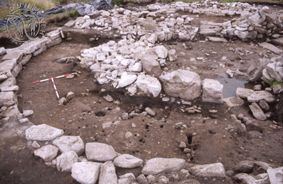Cairn, Halmie
SITE REF: DB18/22g
GRID REF: ND 1171 3345
SITES & MONUMENTS RECORD REF: ND13SW0041
SCHEDULED ANCIENT MONUMENT
Around the edges of the post-medieval settlement cluster of Halmie are scattered a number of structures including what might be hut-circle foundations. These are indications of an earlier occupation of the township site and possible use of the arable area. In an attempt to discover just how far back these structures might date, site DB18/22g was selected for investigation. It had been described in the original Dunbeath Survey as a heather-covered circular bank, approximately 12m in diameter enclosing an apparently U-shaped arc of large sandstone orthostats which appeared to delineate the inner edge of a hut or chamber.
As excavation proceeded it became obvious that the U-shaped setting of massive stones was more circular in form and was surrounded and partly covered by the remains of a large stone cairn. A section through the southern edge of the cairn showed a complex of supporting kerbs or revetments, one quite massive. In the spaces between the lines if stones were quantities of redeposited earth with silts and clays and some traces of charcoal, apparently used as packing material between the stones. Underlying this again was a clay layer with many traces of charcoal and burning, resembling an occupational deposit.
As the infill of broken, slabby stones filling the central 'chamber' area was removed, it could be seen that the bases of the surrounding upright stones were actually lying slightly higher than the floor of the chamber and did not continue down into the underlying ground surface. Many very small shards of undiagnostic pottery have been recovered. They were scattered all over and among the spread of small stones on the south western edge of the cairn. Generalising, they look like the undistinguished pot forms of the later second and early first millennium BC. A segment of jet or lignite armlet has been recovered, sealed under the broken slabs that filled the chamber area and a stone spindle whorl with a beautifully countersunk perforation, possibly dumped with the material from off site.
The site at Halmie is undoubtedly ritual in nature and may be termed a multi-period site within a multi-period landscape. There are obvious elements of change as well as elements of stability. The wider landscape shows a surface or horizontal variety of sites from many periods, the single site showing its chronological stages vertically or in depth. In the beginning (can we ever use this phrase with certainty for any site?) was the original land surface. To the south and north of what has been suggested as the 'entrance passage', on this old land surface, small patches of ard marks have been uncovered, indicating either that the land had been used for agriculture before any structures were built, or that this had been part of the preparation of the site for what was to be constructed there. On this surface, in the course of time, was superimposed a series of structures which may have been related to each other, or perhaps in some stages there was both a chronological and ritual separation between them.
This was a process of setting up and demarcating a ritual area. The inner, open area was defined by a massive stone kerb at one stage and by the orthostatic stones of what has been termed 'the chamber' at another. But even this not too large area of land was made complex within the different stages - rows of stakeholes running out from the centre, but stopping short of the kerb; miniature standing stones set up edge on to the kerb with their sockets cutting into the previously used stakeholes; the 'chamber', with its supporting cairn of earth and stone and the massively slabbed entrance passage from the east where large fires had been lit from time to time.
The successive phases show continuity, certainly in the shape of the demarcated space, if not in the actual structural elements. This open-air ritual site, may have been located not far from the actual settlements of the contemporary populations (the early stages of the investigation of one of the nearby hut circles revealed shards of pottery similar to that found around the ritual site).
(For the later occupation of the site see Alex. Morrison Dunbeath: A Cultural Landscape. Dunbeath Preservation Trust/University of Glasgow Department of Archaeology, 1996).



